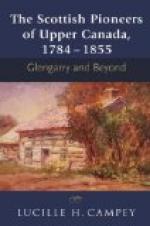The Eskimo hatchets were made of a thick lump of copper about five or six inches long, and one and a half to two inches broad. They were bevelled away at one end like a chisel. This piece of copper was lashed into the end of a piece of wood about twelve or fourteen inches long. The men’s daggers and the women’s knives were also made of copper. The former were in shape like the ace of spades, and the handle was made of reindeer antler.
With the Eskimo was a fine breed of dogs, with erect ears, sharp noses, bushy tails. They were all tethered to stones to prevent them from eating the flesh that was spread all over the rocks to dry. Apparently, these beautiful dogs were left behind still tethered by the wicked Amerindians, after the massacre of their owners. Hearne, however, noticed with these Coppermine River Eskimo that the men were entirely bald, having all their head hair pulled out by the roots. The women wore their hair at the usual length.
Before leaving this region to return southwards, Hearne was led by the Indians to one of the copper mines about thirty miles south-east of the river mouth. It was no more than a jumble of rocks and gravel, which had been rent in many ways, apparently by an earthquake shock. This mine was at the time of Hearne’s visit very poor in copper, much of the metal having already been removed.
The Copper Indians set a great value on this native metal even at the present day, and prefer it to iron for almost every use except that of a hatchet, a knife, and an awl. “For these three necessary implements”, writes Hearne, “copper makes but a very poor substitute.”
On the return journey, in the course of which the Great Slave Lake—which Hearne calls “Lake Athapuscow”—was discovered and crossed on the ice, the party travelled so hard and stayed so seldom to rest that Hearne suffered terribly with his legs and feet. “I had so little power to direct my feet when walking, that I frequently knocked them against the stones with such force, as not only to jar and disorder them, but my legs also; and the nails of my toes were bruised to such a degree, that




